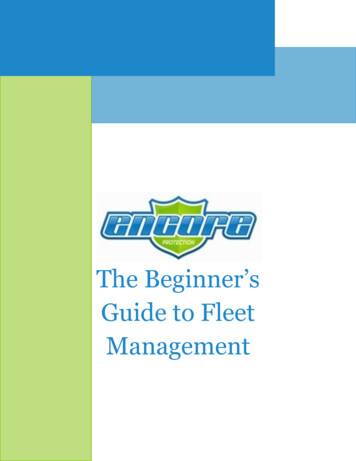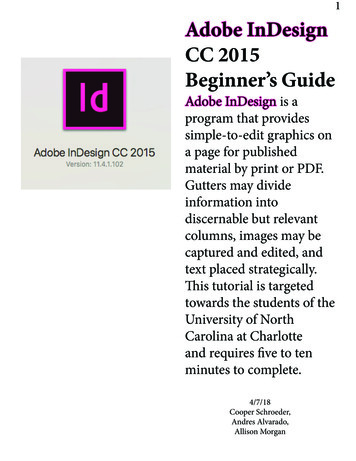
Transcription
The Beginner’sGuide to FleetManagement
The Beginner’s Guide to Fleet ManagementPage 2FLEET MANAGEMENT: DEFINEDIn today’s modern world, fleets can come in many different shapes and sizes. Technically speaking, both alarge, nationally-operating trucking company and a small, locally-operating delivery company areconsidered fleets. So, if you fall into either of these categories or anywhere in between, you’ve got a fleet torun. Regardless of the size and operating procedures of your fleet, you need a comprehensive fleetmanagement program to keep your fleet running as efficiently as possible.At its core, fleet management covers the practices ofoverseeing, organizing, and recording all aspects of acompany’s fleet. These managerial duties mightinclude, but aren’t limited to, establishing regularvehicle maintenance schedules, establishing costsaving measures, and implementing new drivertraining programs. Depending your company’s sizeand the industry in which you operate, how large andvaried your fleet is, fleet management practices varymore as the aspect of management grows morespecific.Whether you wear many hats and only one of your duties is fleet management, or whether “fleet manager”is in your job title, this beginner’s guide will walk you through the basics of fleet management and how tobuild your own company’s successful fleet management program (FMP) from the ground up.Primary ResponsibilitiesYou have a lot of primary responsibilities to keep in mind when establishing your company’s fleetmanagement program. These requirements will inform your decisions every step of the way, from trainingdrivers to acquiring vehicles. Recording and maintaining accurate data and information on all aspects of the fleet.Example: Fleet managers are often responsible for keeping detailed maintenance histories forall vehicles in the fleet. They should be able to find the exact date of a specific truck’s lastoil change by looking through well-kept records.Assessing, managing, and mitigating all associated risks at every level of your organization.Example: Fleet management programs should include advanced screening policies for alldrivers, as well as rigorously enforced safe-driving policies and training programs, tolower the risk of traffic incidents involving its fleet vehicles.
The Beginner’s Guide to Fleet Management Page 3Analyzing recorded data, extrapolating issues from the data, and recommending solutions.Example: Fleet managers should be able to view common routes that their vehicles take andidentify alternate routes or travel schedules for decreasing idle times and avoiding heavytraffic patterns.Establishing situational processes and procedures for a variety of scenarios and circumstancesthat the fleet may encounter.Example: A good fleet management program has a detailed plan of action for situationsinvolving on-road incidents, such as vehicle breakdowns, failed inspections, or trafficcrashes.Benefits of Fleet ManagementA successful fleet management program boosts your company’s well-being with: Lowered costs, greater returns—by limiting inefficient business practices such as excessiveidling or out-of-the-way travel routes, fleet managers can reduce fuel consumption and increaseproductivity.Increased overall business efficiency—the positive results from having a well-run fleet canoverflow into other areas of the company as well. Customers receiving their goods and services ina timely manner are likely to become repeat customers. Regular vehicle maintenance can lead toreduced instances of costly vehicle breakdowns that cut into the company’s overall annualbudget.Improved employee happiness—an impartial structure and established company policiesapplied fairly and accurately across all levels of employment leads to increased employeesatisfaction with the company and with their own jobs.Strengthened corporate peace-of-mind—a good fleet management program reassures c-suiteindividuals and decision-making boards that the company is maximizing its successes andminimizing its risks.Essentially, it boils down to this: if your business needs multiple vehicles to properly function, you needsome form of fleet management to ensure that your fleet is operating safely and to its greatest potential.DIFFERENT TYPES OF FLEETSAs mentioned earlier, there are many different kinds of fleets, and the type of fleet that your company haswill play a big part in determining how you proceed with the establishment of your fleet managementprogram.
Page 4The Beginner’s Guide to Fleet ManagementSmall BusinessesThe U.S. Small Business Association (SBA) defines a small business in the transportation industry as onethat does 27.5 million or less in average annual receipts (for truck transportation) or 15 million or less inaverage annual receipts (for transit and ground passenger transportation).1 Examples of small businessfleets include: Florist and gift delivery businessesCatering and food delivery companiesCleaning service companiesElectrician/plumbing/HVAC companiesLandscaping businessesLarge BusinessesAnother metric that is often used to differentiate between small and large businesses is employmentfigures: businesses with more than 500 employees are typically considered large businesses. 2 While thereis technically no single agreed-upon threshold for the number of vehicles a fleet requires to be categorizedas “large,” bigger fleet businesses tend to have at least 200 vehicles or more.Examples of large business fleets include: Rental car/truck companiesMoving companiesTaxi companiesDelivery companiesLong haul semi-truck companiesDetermining Your Fleet NeedsThe first step to evaluating your fleet management requirements is determining the type of fleet that yourcompany will need. Consider the following discussion questions when mapping out your FMP. What is your business classification?Does your company fall into the small business category, the large business category, orsomewhere in between?What industries does your business work within? Does this affect its classification?
The Beginner’s Guide to Fleet Management Page 5How many vehicles will you need?How many vehicles does your company currently have, if any?In an ideal situation, how many vehicles would you like to add to your fleet and why?What types of vehicles will you need?Will you need sedans, delivery vans, work trucks, semi-trucks?Will your company require a fleet that comprises several different vehicle types?ACQUIRING VEHICLESAfter establishing a preliminary list of fleet requirements, you can move forward with the process ofacquiring your fleet’s vehicles.Selecting Your FleetAs mentioned above, selecting the most appropriate types of vehicles according to your business’spurpose is crucial. For example, a residential cleaning service business would probably need sedans andminivans whereas a freight delivery company will likely deal exclusively in heavy duty and super heavyduty trucks.Primary Acquisition OptionsCompanies can acquire vehicles for their fleet through two primary methods: purchasing or leasing.However, you aren’t restricted to methodology or the other, as “there may be financial and operationalreasons to alternate between procurement methods.”3 Company Vehicle Purchase: In this type of acquisition, the company directly purchases a fleetvehicle from a trusted source, whether that is a dealership, auction house, or other verifiedindependent reseller. One advantage of buying your fleet vehicles outright is the ability to applyyour logo and branding uniformly across your fleet.4 Also, many car manufacturers anddealerships offer fleet discounts for companies interested in purchasing vehicles in bulk. 5Unfortunately, there is a heavy front-end financial investment involved in buying vehicles.
The Beginner’s Guide to Fleet Management Page 6Company Vehicle Lease: In the case of vehicle acquisition through leasing, your company wouldsign a leasing agreement with the organization or business that owns the vehicles. This agreementwould cover all the terms of the lease, including monthly payments, maintenance requirementsand mileage stipulations, and the length of the lease. When leasing fleet vehicles, you tend tolower monthly costs and have the ability to update your fleet every few years. “Leasing alignswell with economic life cycling, resulting in the ability to operate a more current fleet ofvehicles.”6 One of the biggest downsides to leasingis that, oftentimes, the lessee is on-the-hook forany damage to the vehicle upon leasetermination.7 Insurance can mitigate this risk, butit still presents an important consideration for thefleet manager.Other ConsiderationsGreen Fleets: In recent years, as global climate change and environmentalism have moved to the forefrontof the public scene, many companies have begun migrating their fleets from traditional fuel sources suchas gasoline and diesel to more environmentally friendly options. There are a number of reasons to consider“greener” options for your fleet vehicles. A properly managed green fleet “can significantly reduce lifecyclecosts and vulnerability to volatile fuel prices.”8 Additionally, green vehicles can significantly cut down onyour fleet’s emissions, which “is an immediate and meaningful way to reduce your company’s carbonfootprint.” Plus, numerous studies have found that consumers view companies more favorably when theyhave sustainable or environmentally-friendly business practices.9And, while improving your company’s public perception may be reason enough to consider a green fleet,it’s also important to note that recently proposed legislation could force transportation industries to focuson greener fleet options. In a joint effort, the Environmental Protection Agency (EPA) and the NationalHighway Traffic Safety Administration (NHTSA) introduced “new fuel-efficiency and carbon-cuttingstandards that would slash pollution by large trucks and other vehicles.”10FLEET DRIVERS: HIRING AND TRAININGHiringThere are a number of different qualifications and characteristics that you should look for when hiringfleet employees. These qualifications will vary based on the classifications of vehicles in your fleet, butgood baseline requirements should include the following.
The Beginner’s Guide to Fleet Management Page 7The applicant must have a valid driver’s license with the appropriate class requirements. In manycases, truck drivers may need to have a commercial driver’s license (CDL) to operate your fleet’svehicles. Similarly, a driver’s CDL must be of the appropriate class for the type of vehicle they willbe operating.The applicant must have the mental andphysical capability of safe vehicle operation.Most types of commercial driving requiredrivers to undergo a qualified Department ofTransportation (DOT) physical to obtain aDOT medical card.11 This card certifies that thedriver has been medically cleared for thedemands of a commercial driving job by aCertified Medical Examiner on the FMCSANational Registry.12The applicant must pass a certified preemployment drug and alcohol screening.The applicant must have an appropriate amount of experience. While this requirement may varygreatly from business to business, you will likely want someone who has had their license for anextended period of time and who has driven in a variety of conditions. Other information youshould consider requesting include equipment operated, miles driven, transferable workexperience, and a history of stable employment.13The applicant must have a clean driving record. Each company has different standards for this,but when individuals apply for a CDL, the Federal Motor Carrier Safety Administration(FMCSA) will check driving records going back at least ten years.14The applicant should provide several references from previous places of employment. As with anyjob, calling an individual’s former employer(s) offers an opportunity to learn about the jobcandidate from a third party. This allows you to learn about someone’s work ethic, on-the-jobbehavior, personality, skill level, and competence in the field.TrainingIdeally, your fleet drivers will start at your company with an adequate level of experience and training, butthere are advantages to offering supplemental training opportunities. These company-sponsored trainingprograms could include instructions for driving on different types of terrain, first aid training, educationon the dangers of distracted and impaired driving, and more. You may also want to offer opportunities forless-experienced members of your team to do ridealongs with veteran drivers for hands-on, real worldtraining.
The Beginner’s Guide to Fleet ManagementPage 8Additionally, offering both mandatory and optional training programs on a regular basis is a valuable wayto keep your drivers up-to-date on industry news and trends, revised company protocols, and any otherapplicable updates and changes. This combination of ongoing on-road and off-road training initiativesensures that your drivers will be operating your fleet vehicles safely and effectively.FLEET TRACKINGOne of the newest major developments in the fleet industry is the dawn and spreading of fleet trackingsystems. “GPS fleet-tracking software works in tandem with a piece of GPS hardware installed in thevehicle. It uses global positioning systems (that's what GPS stands for, by the way) via satellites to trackvehicles and drivers in real time. It gives users access to real-time updates and alerts using data that issent directly from the vehicle to the software operator.”15“The primary objectives of an FMS [fleet management system] are to improve the management of vehiclefleets and to reduce their operating costs.”16 However, there are a number of advantages to implementing afleet tracking system into your fleet management program. Operations: Fleet tracking systems monitor avariety of metrics such as driving routes, idlingtimes, driver down-times, vehicle location, and
The Beginner’s Guide to Fleet Management Page 2 FLEET MANAGEMENT: DEFINED In today’s modern world, fleets can come in many different shapes and sizes. Technically speaking, both a large, nationally-operating trucking company and a small, locally-operating delivery company are considered fleets. So, if you fall into either of these categories or anywhere in between, you’ve got a fleet to











